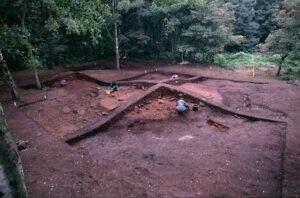
Durham University—Archaeologists have found what they say is the first solid scientific evidence suggesting that Vikings crossed the North Sea to Britain with dogs and horses.
Research led by Durham University, UK, and the Vrije Universiteit Brussels, Belgium, examined human and animal remains from Britain’s only known Viking cremation cemetery at Heath Wood, in Derbyshire.
Scientists looked at strontium isotopes contained within the remains. Strontium is a natural element found in different ratios across the world and provides a geographical fingerprint for human and animal movements.
Their analysis showed that within the context of the archaeology, one human adult and several animals almost certainly came from the Baltic Shield area of Scandinavia, covering Norway and central and northern Sweden, and died soon after arrival in Britain.
The researchers say this suggests that Vikings were not only stealing animals when they arrived in Britain, as accounts from the time describe, but were also transporting animals from Scandinavia, too.
As the human and animal remains were found in the remnants of the same cremation pyre, the researchers believe the adult from the Baltic Shield region may have been someone important who was able to bring a horse and dog to Britain.
The analysed remains are associated with the Viking Great Army, a combined force of Scandinavian warriors that invaded Britain in AD 865.
The findings are published in the scientific journal PLOS ONE.
Lead author Tessi Löffelmann, a doctoral researcher jointly working in the Department of Archaeology, Durham University, and the Department of Chemistry, Vrije Universiteit Brussels, said: “This is the first solid scientific evidence that Scandinavians almost certainly crossed the North Sea with horses, dogs and possibly other animals as early as the ninth century AD and could deepen our knowledge of the Viking Great Army.
“Our most important primary source, the Anglo-Saxon Chronicle, states that the Vikings were taking horses from the locals in East Anglia when they first arrived, but this was clearly not the whole story, and they most likely transported animals alongside people on ships.
“This also raises questions about the importance of specific animals to the Vikings.”
The researchers analyzed strontium ratios in the remains of two adults, one child and three animals from the Heath Wood site.
Strontium occurs naturally in the environment in rocks, soil and water before making its way into plants. When humans and animals eat those plants, strontium replaces calcium in their bones and teeth.
As strontium ratios vary in different parts of world the geographical fingerprint of the element found in human or animal remains can help show where they came from or settled.
Strontium ratios in one of the adults and the child showed that they could have been from the area local to the Heath Wood cremation site, southern or eastern England or from Europe, including Denmark and south-west Sweden which were outside of the Baltic Shield region.
But the remains of the other adult and all three animals – a horse, a dog and what the archaeologists say was possibly a pig – had strontium ratios normally found in the Baltic Shield area.
While the researchers say their findings suggest the horse and dog were transported to Britain, it may be that the pig fragment was a piece from a game or another talisman or token brought from Scandinavia, rather than a live pig. The remains had also been cremated and buried under a mound, which the researchers say could be a link back to Scandinavian rituals at a time when cremation was absent in Britain.
Research co-author Professor Janet Montgomery, in the Department of Archaeology, Durham University, said: “Our study suggests that there are people and animals with different mobility histories buried at Heath Wood, and that, if they belonged to the Viking Great Army, it was made up of people from different parts of Scandinavia or the British Isles.
“This is also the first published strontium analysis on early medieval cremated remains from Britain and shows the potential that this scientific method has to shed further light on this period in history.”
The research team also included archaeologists from the University of York, UK, who excavated the Heath Wood cemetery between 1998 and 2000, and the Université Libre de Bruxelles, Belgium.
Professor Julian Richards, of the Department of Archaeology, University of York, who co-directed the excavations at the Heath Wood Viking cemetery, said: “The Bayeux Tapestry depicts Norman cavalry disembarking horses from their fleet before the Battle of Hastings, but this is the first scientific demonstration that Viking warriors were transporting horses to England two hundred years earlier.
“It shows how much Viking leaders valued their personal horses and hounds that they brought them from Scandinavia, and that the animals were sacrificed to be buried with their owners.”
The research was funded by Arts and Humanities Research Council (Northern Bridge) funding, the Vrije Universiteit Brussels, and The Rosemary Cramp Fund and the Institute of Medieval and Early Modern Studies, both Durham University.
______________________________

Viking burial mound at Heath Wood being excavated. Credit: Julian Richards, University of York.
______________________________
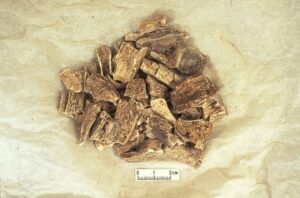
Cremated animal and human bone from the Heath Wood Viking cemetery. Credit: Julian Richards, University of York
______________________________
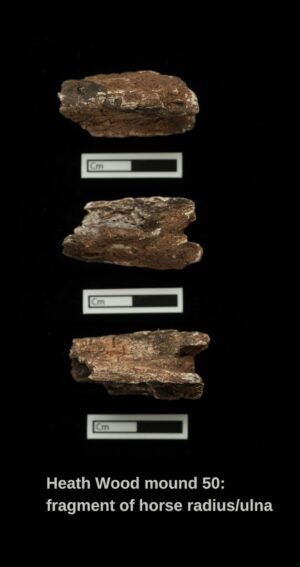
Fragment of a sampled cremated horse radius/ulna from burial mound 50 at Heath Wood. Credit: Jeff Veitch, Durham University.
______________________________
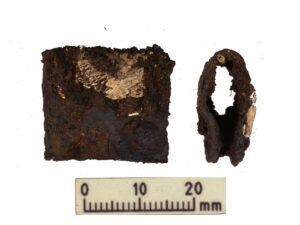
Clasp from the Viking warrior’s shield found during the original excavations in 1998-2000. The clasp was found in the same grave as the human and animal remains analysed during the latest research. Credit: Julian Richards, University of York.
______________________________
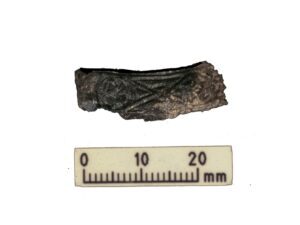
Decorated hilt guard from the Viking warrior’s sword. The sword was found in the same grave as the human and animal remains analysed during the latest research. Credit: Julian Richards, University of York.
______________________________
Article Source: Durham University news release
______________________________
About the Arts and Humanities Research Council
The Arts and Humanities Research Council (AHRC), part of UK Research and Innovation, funds internationally outstanding research across all arts and humanities. This includes research which supports important UK economic sectors such as the creative and digital industries, creative practice and arts in all its forms. Our research also explores complex social and cultural issues that underpin our understanding of our interaction with society, ourselves and the natural world. We invest in research which places humanity at the heart of today’s biggest questions and their answers.
About Durham University
Durham University is a globally outstanding centre of teaching and research based in historic Durham City in the UK.
We are a collegiate university committed to inspiring our people to do outstanding things at Durham and in the world.
We conduct boundary-breaking research that improves lives globally and we are ranked as a world top 100 university with an international reputation in research and education (QS World University Rankings 2023).
We are a member of the Russell Group of leading research-intensive UK universities and we are consistently ranked as a top 10 university in national league tables (Times and Sunday Times Good University Guide, Guardian University Guide and The Complete University Guide).
For more information about Durham University visit: www.durham.ac.uk/about-us/
__________________________________
Advertisement
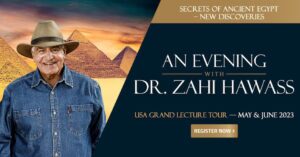
Don’t miss out on this unforgettable evening as Dr. Hawass reveals the most closely guarded secrets of ancient Egypt and presents his groundbreaking new discoveries and latest research live on stage. As the man behind all major discoveries in Egypt over the last few decades and director of several ongoing archaeological projects, Dr. Hawass may yet surprise you with unexpected revelations that will make news across the world.
__________________________________





